
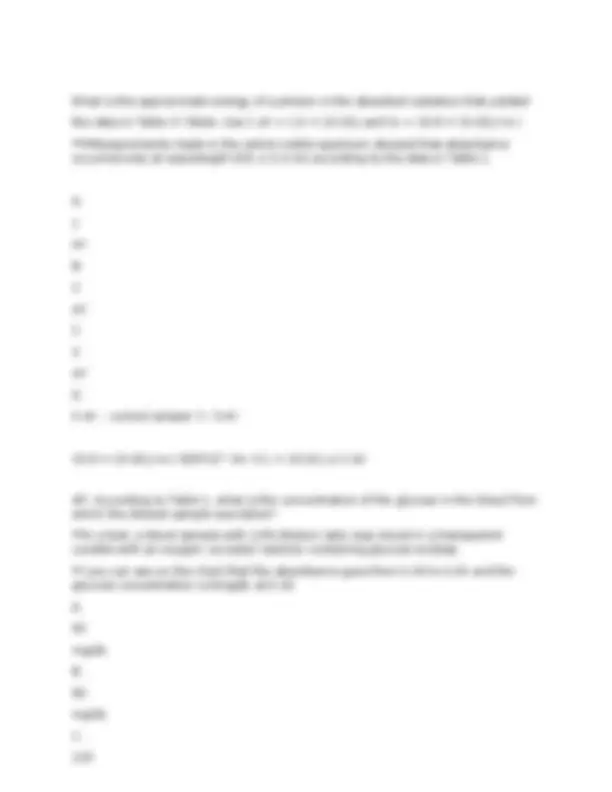

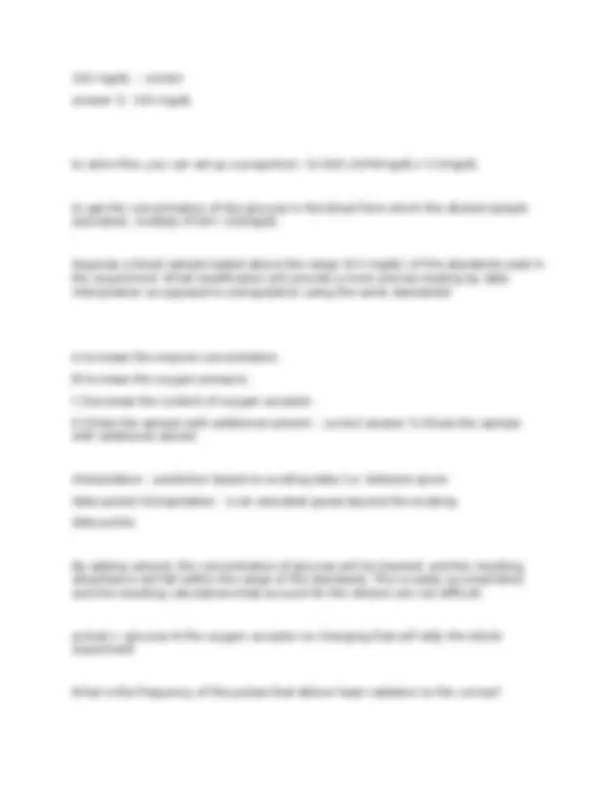
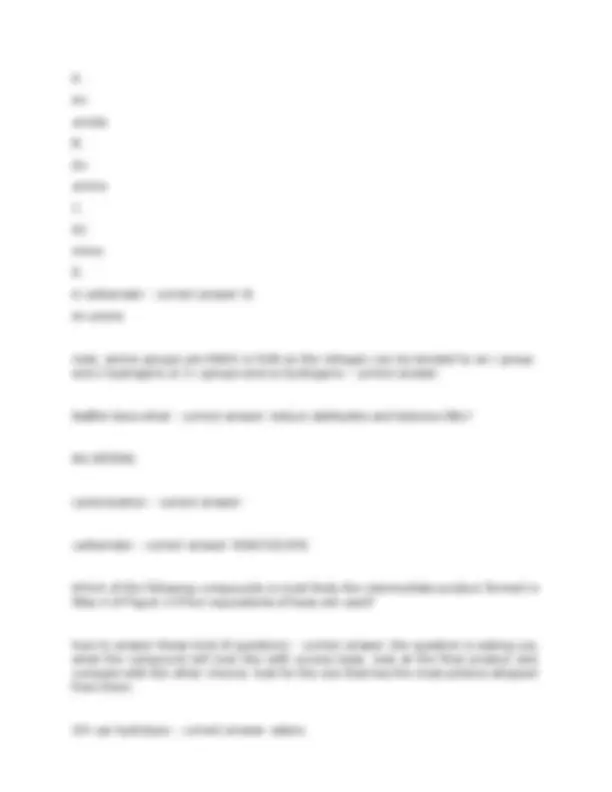
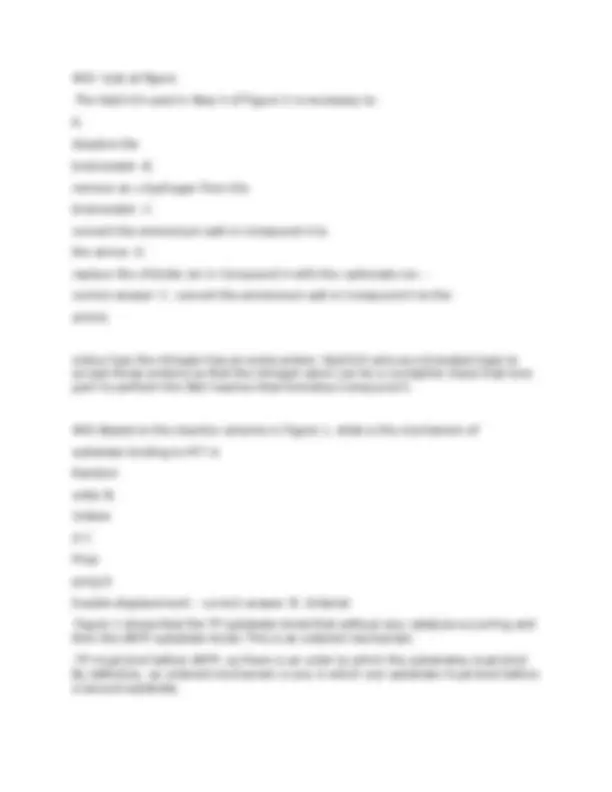
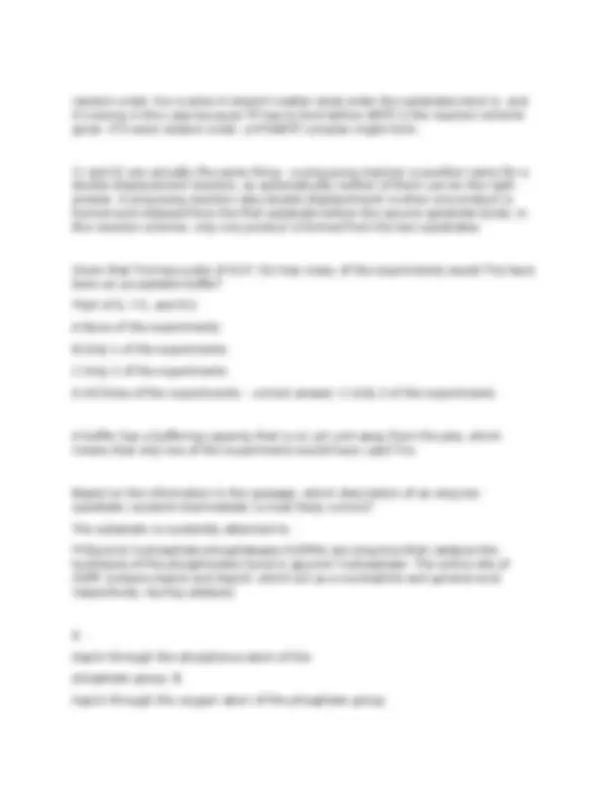

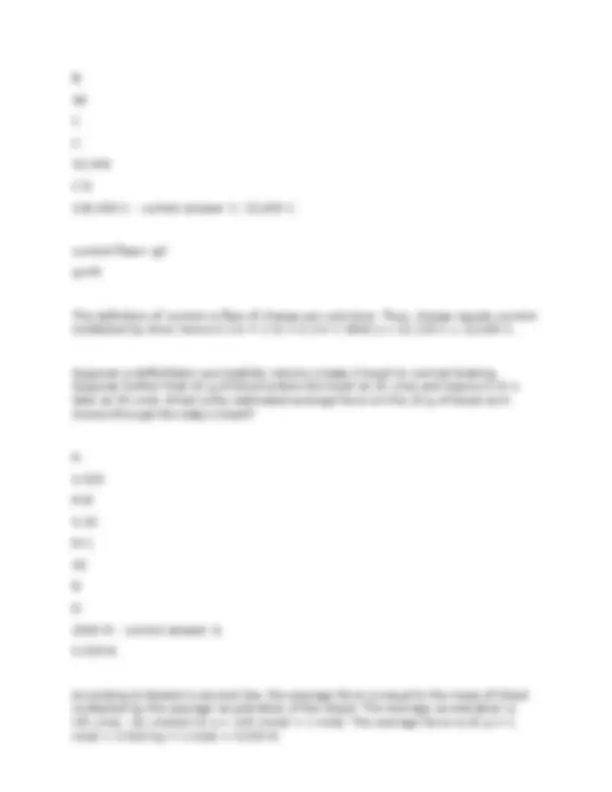
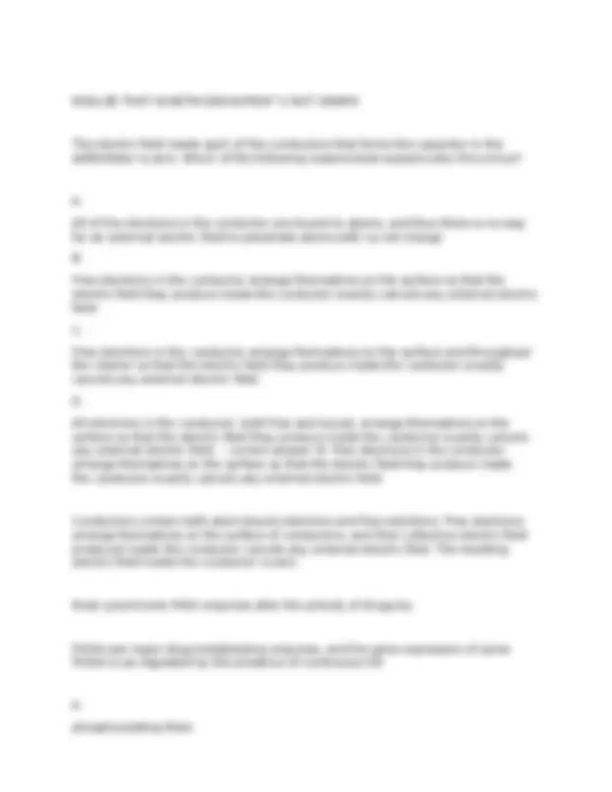
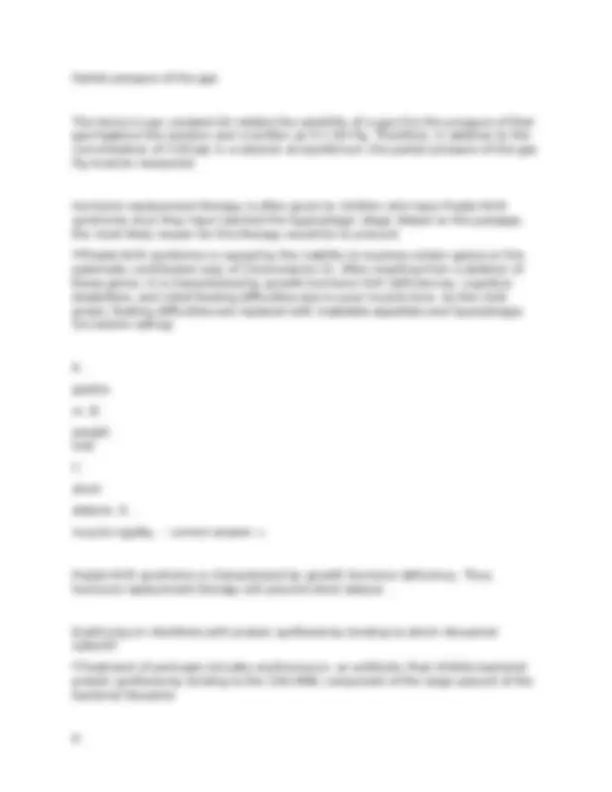
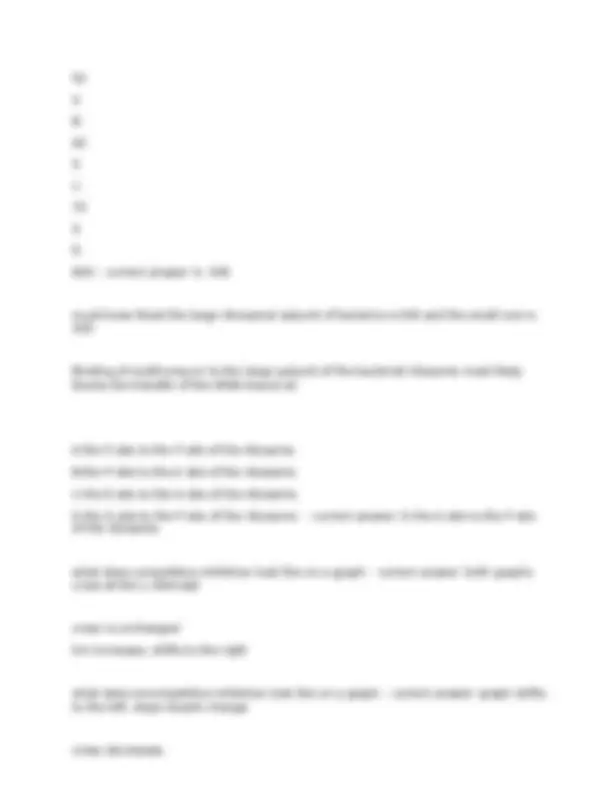

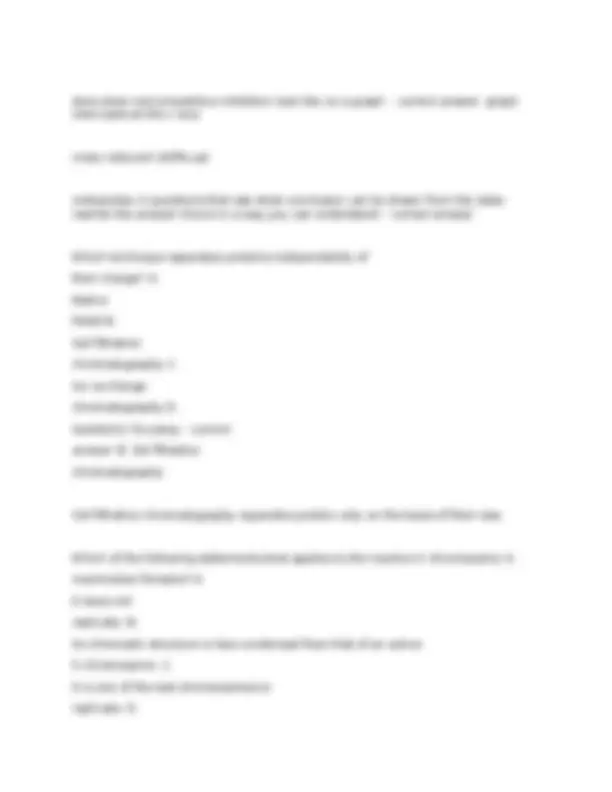
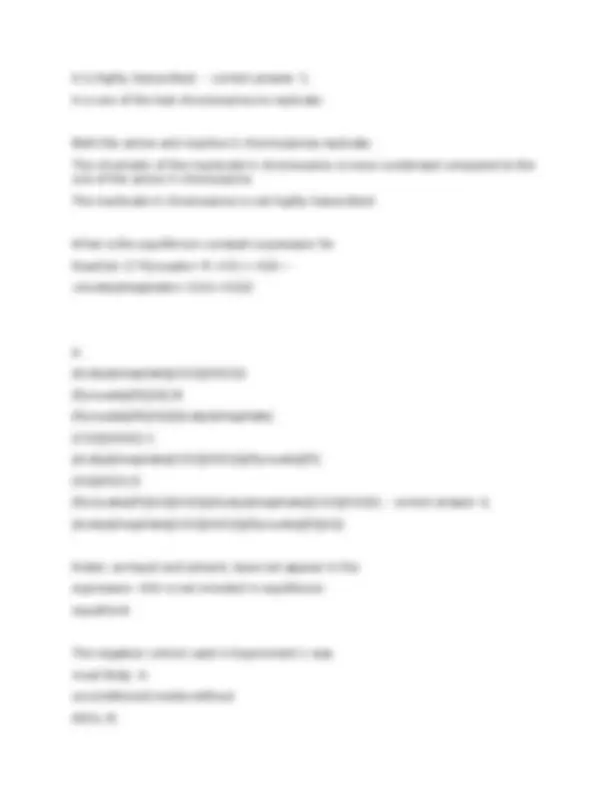
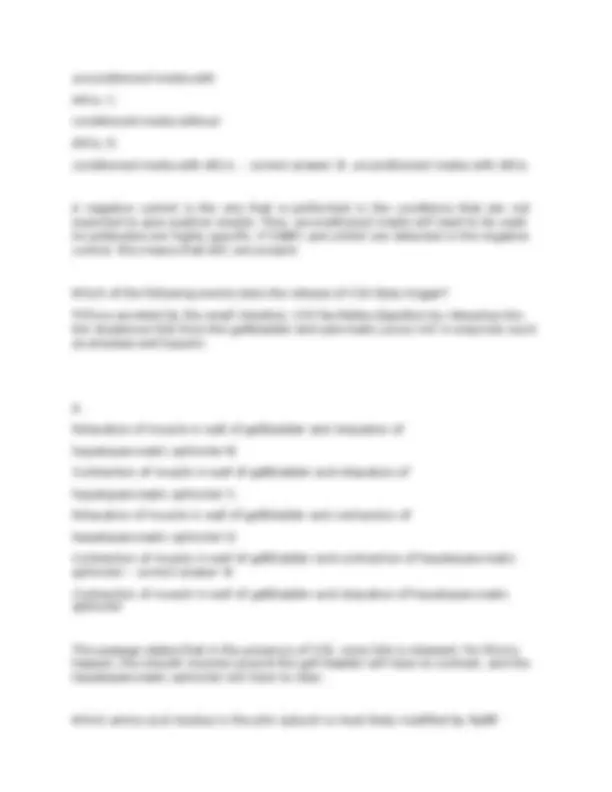
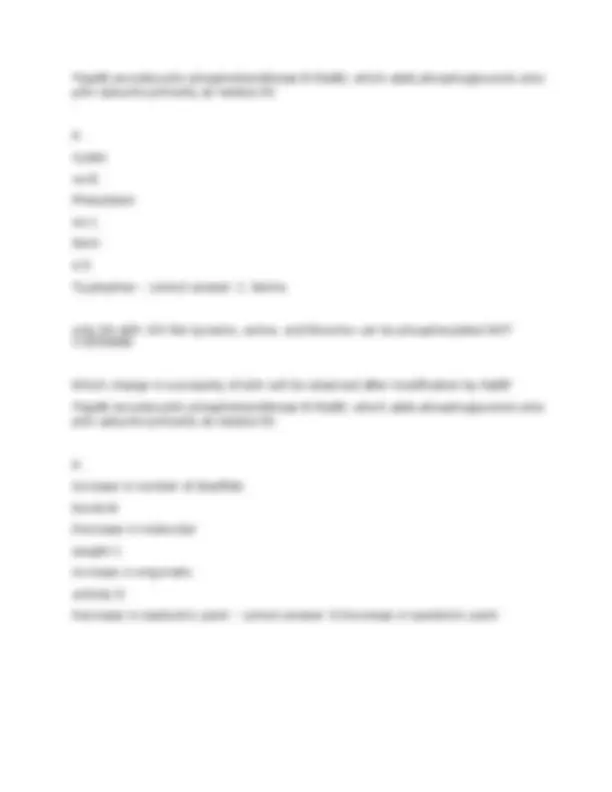
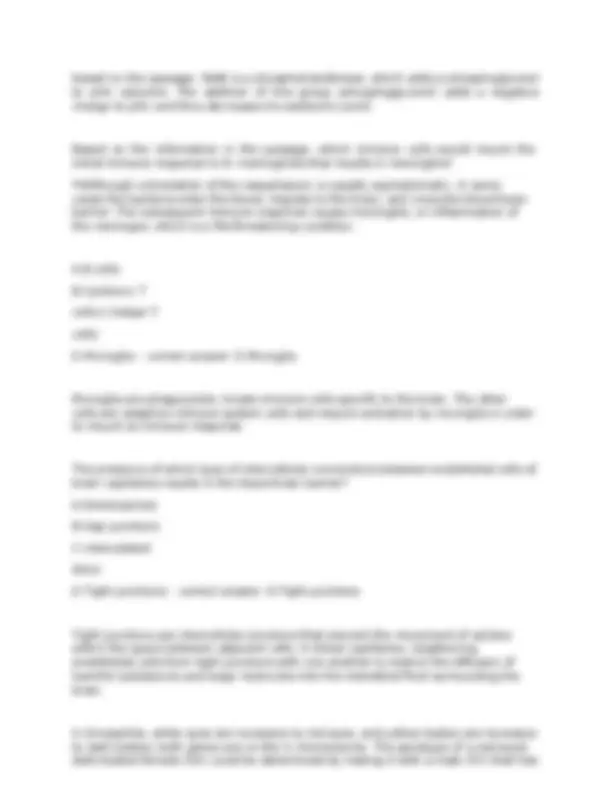

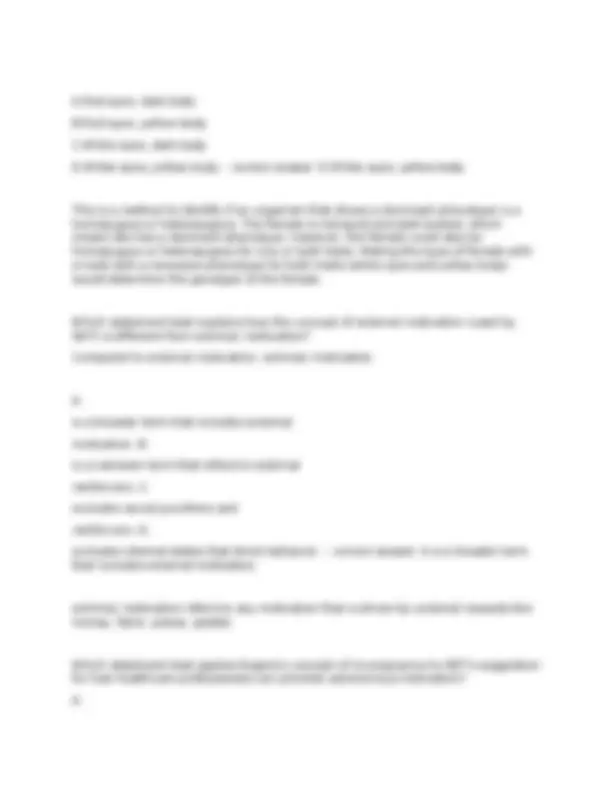
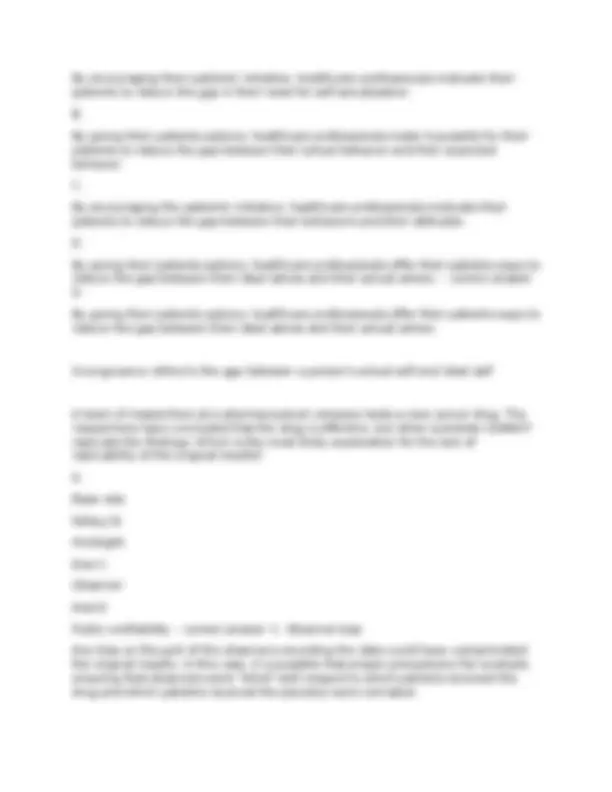
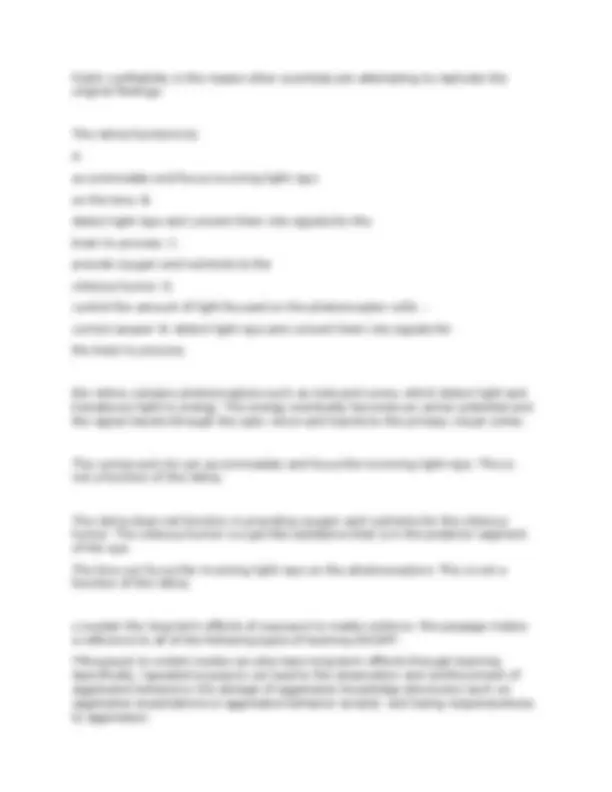
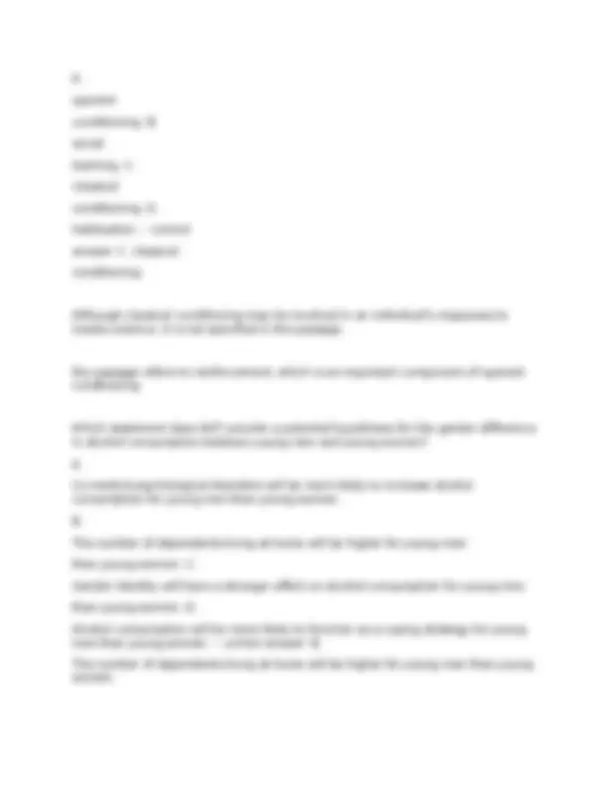
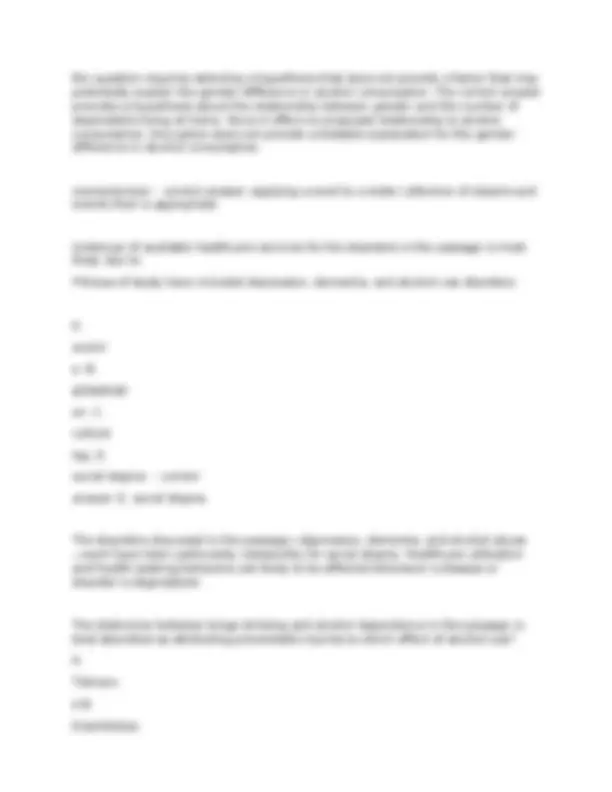
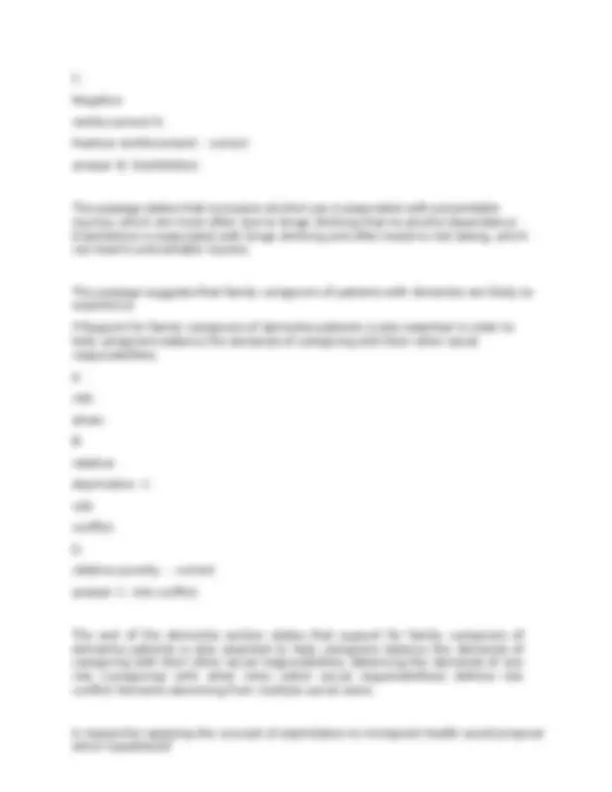

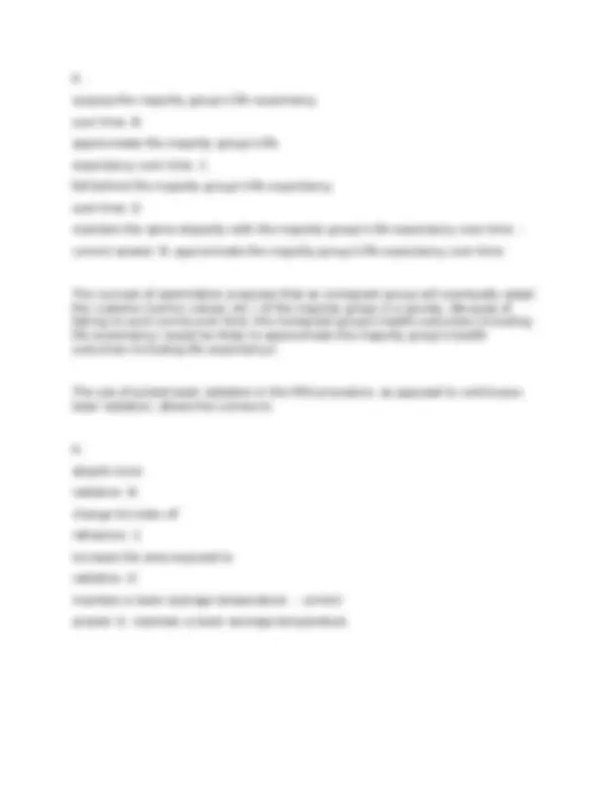


Study with the several resources on Docsity

Earn points by helping other students or get them with a premium plan


Prepare for your exams
Study with the several resources on Docsity

Earn points to download
Earn points by helping other students or get them with a premium plan
Community
Ask the community for help and clear up your study doubts
Discover the best universities in your country according to Docsity users
Free resources
Download our free guides on studying techniques, anxiety management strategies, and thesis advice from Docsity tutors
AAMC practice exam 4 Questions with 100% correct answers 2024
Typology: Exams
1 / 34

This page cannot be seen from the preview
Don't miss anything!



























Limestone does NOT decompose when heated to 900 K because, at 900 K, ΔH is: *The chemist placed a sample of limestone, CaCO3(s), into a sealed chamber and then heated the limestone to 1200 K to generate CO2(g) and CaO(s). A. positive and less than TΔS. B. positive and greater than TΔS. C. negative and less than TΔS. D. negative and greater than TΔS. - correct answer A. positive and less than TΔS. think about it, if H is positive and less than TS than G is positive and the reaction is non spontaneous. that is why it won't decompose at 900K, need more heat When limestone is heated during Step 1, an equilibrium is established. Which of the following expressions is the equilibrium constant for the decomposition of limestone? **The chemist placed a sample of limestone, CaCO3(s), into a sealed chamber and then heated the limestone to 1200 K to generate CO2(g) and CaO(s). A. [Ca O] B.
[CaCO 3] C. [CO2] D. [CaO] × [CaCO3] - correct answer C. [CO2] SOLIDS ARE EXCLUDED FROM EQUILIBRIUM RXNS CaCO3(s) --->CO2(g) + CaO(s) products/reactant, no solids, so only Co2 is the answer During Reaction 2, did the oxidation state of N change? **NH3(aq) + CO2(aq) + H2O(l) → NH4+(aq) + HCO3-(aq) A. Yes; it changed from - to -4. B. Yes; it changed from 0 to +1. C. No; it remained at -3. D. No; it remained at +1. - correct answer C. No; it remained at - 3. this is an acid-based reaction, which does not involve the oxidation state changes. The part of Reaction 2 that involves nitrogen is the protonation of ammonia (NH3 + H+ →NH4+). Acid- base reactions do not involve oxidation state changes. The oxidation state of N in NH3 is -3. Each H is +1 and is balanced by the -3 of N to make a neutral compound. The oxidation state of N does not change when the N is protonated.
mg/dL D.
150 mg/dL - correct answer D. 150 mg/dL to solve this, you can set up a proportion. (0.20/0.24)6mg/dL= 5.0mg/dL to get the concentration of the glucose in the blood from which the diluted sample was taken, multiply 530= 150mg/dL Suppose a blood sample tested above the range (6.0 mg/dL) of the standards used in the experiment. What modification will provide a more precise reading by data interpolation as opposed to extrapolation using the same standards? A.Increase the enzyme concentration. B.Increase the oxygen pressure. C.Decrease the content of oxygen acceptor. D.Dilute the sample with additional solvent - correct answer D.Dilute the sample with additional solvent Interpolation - prediction based on existing data (i.e. between given data points) Extrapolation - is an educated guess beyond the existing data points By adding solvent, the concentration of glucose will be lowered, and the resulting absorbance will fall within the range of the standards. This is easily accomplished, and the resulting calculations that account for the dilution are not difficult. picked c- glucose IS the oxygen acceptor so changing that will defy the whole experiment What is the frequency of the pulses that deliver laser radiation to the cornea?
1 M - correct answer B.0.01 M know that this is an equilibrium problem and that the products and reactnat s are a 1:1 ratio. so the answer is the sqrt of 1.76 × 10-5 which is 0. quick maths square the exponent sqrt10^-4 = 10^-2=. What is the concentration of the acute leukemia CC95 Combination value in micromolar (μM) units? 0.6nM A. 6 × 10- μM B. 6 × 10- μM C. 6 × 10- 4 μM D. 6 × 10-2 μM - correct answer C.6 × 10- 4 μM 0.6x10^-9/0.610^-6= 0.610-3= 6*10^- 4 REALIZE WHEN THE ANSWER CHOICES ARE A DECIMAL OFF AND CHANGE THE EXPONENTS TO MATCH 0.6 to 6---> add another exponent 10^-3 to 10^- 4 Which of the following functional groups is present in pyrrolizidine (Figure 1)?
An amide B. An amine C. An imine D. A carbamate - correct answer B. An amine note: anime groups are RNH2 or R3N so the nitrogen can be bonded to an r group and 2 hydrogens or 3 r groups and no hydrogens - correct answer NaBh4 does what - correct answer reduce aldehydes and ketones ONLY NO ESTERS Lactonization - correct answer carbamate - correct answer R2NCO2C2H Which of the following compounds is most likely the intermediate product formed in Step 4 of Figure 2 if four equivalents of base are used? how to answer these kind of questions - correct answer the question is asking you what the compound will look like with excess base. look at the final product and compare with the other choices. look for the one that has the most protons stripped from them OH can hydrolyze - correct answer esters
random order- his is when it doesn't matter what order the substrates bind in, and it's wrong in this case because TP has to bind before dNTP in the reaction scheme given. If it were random order, a RT/dNTP complex might form. C) and D) are actually the same thing - a ping-pong reaction is another name for a double displacement reaction, so automatically neither of them can be the right answer. A ping-pong reaction (aka double displacement) is when one product is formed and released from the first substrate before the second substrate binds. In this reaction scheme, only one product is formed from the two substrates. Given that Tris has a pKa of 8.07, for how many of the experiments would Tris have been an acceptable buffer? **pH of 6, 7.5, and 8. A.None of the experiments B.Only 1 of the experiments C.Only 2 of the experiments D.All three of the experiments - correct answer C.Only 2 of the experiments A buffer has a buffering capacity that is ±1 pH unit away from the pKa, which means that only two of the experiments would have used Tris. Based on the information in the passage, which description of an enzyme- substrate covalent intermediate is most likely correct? The substrate is covalently attached to: **Glycerol 3-phosphate phosphatases (G3PPs) are enzymes that catalyze the hydrolysis of the phosphoester bond in glycerol 3-phosphate. The active site of G3PP contains Asp14 and Asp16, which act as a nucleophile and general acid, respectively, during catalysis. A. Asp14 through the phosphorus atom of the phosphate group. B. Asp14 through the oxygen atom of the phosphate group.
Asp16 through the phosphorus atom of the phosphate group. D. Asp16 through the oxygen atom of the phosphate group. - correct answer A. Asp14 through the phosphorus atom of the phosphate group. Asp acts as the nucleophile, with its side chain -OH group. the OH will not attack another O, so it wil go for the phosphorus What is the [H3O+] in the solution used in the experiment done at the lowest pH? *pH of 6 A.
μM B.
μM C.
μM D. 100 μM - correct answer C.1.0 μM pH of 6= 1x10^-6 M= C. 1.0 μM Based on the data in Table 1, what are the effects of increasing pH on catalytic efficiency and the maximum velocity of the reaction? A. Both the catalytic efficiency and the maximum velocity of the reaction increase. B. The catalytic efficiency increases with pH, but the maximum velocity of the reaction decreases.
136,000 C - correct answer C. 15,000 C current flow= q/t q=i*t The definition of current is flow of charge per unit time. Thus, charge equals current multiplied by time, hence 4.2 A × 1 hr = 4.2 A × 3600 s = 15,120 C ≈ 15,000 C. Suppose a defibrillator successfully returns a baby's heart to normal beating. Suppose further that 20 g of blood enters the heart at 25 cm/s and leaves 0.10 s later at 35 cm/s. What is the estimated average force on the 20 g of blood as it moves through the baby's heart? A.
N B.
N C. 20 N D. 2000 N - correct answer A. 0.020 N According to Newton's second law, the average force is equal to the mass of blood multiplied by the average acceleration of the blood. The average acceleration is (35 cm/s - 25 cm/s)/0.10 s = 100 cm/s2 = 1 m/s2. The average force is 20 g × 1 m/s2 = 0.020 kg × 1 m/s2 = 0.020 N.
dephosphorylating them. C. oxidizing them. D. reducing them. - correct answer C. oxidizing them Cytochrome P450 acts as monooxygenases, where an oxygen atom is inserted into a substrate (the drug of interest), thereby resulting in the oxidation of the substrate. a shorter half life means a (faster/slower) metabolism - correct answer a shorter half life means a faster metabolism. it would take less time to metabolize a compound, resulting in a lower half life. A defining characteristic of proteins that act as transcription factors (such as STAT5b) is that they: A. can dimerize. B. can phosphorylate other proteins. C. contain a DNA binding domain. D. are present within the nucleus of the cell. - correct answer C. contain a DNA binding domain. During the ACC1- or ACC2-catalyzed formation of malonyl-CoA, what is the structure of the functional group added to acetyl-CoA? A. phosphate group B. hydroxyl group C. carboxyl group D. methyl group - correct answer C. carboxyl group
they are CARBOXYLASES which add carboxyl groups As blood passes through actively contracting skeletal muscle tissue, the affinity of hemoglobin for oxygen in the muscle tissue: A. increases as a result of an increase in plasma temperature. B. increases as a result of an increase in plasma PO2. C. decreases as a result of a decrease in plasma pH. D. decreases as a result of a decrease in plasma PCO2. - correct answer C. decreases as a result of a decrease in plasma pH. Affinity would decrease with a decrease in plasma pH, and during prolonged exercise, anaerobic respiration would decrease the plasma pH. A researcher measures the concentration of CO2(aq) in a solution at equilibrium. Which additional quantity must be measured in order to calculate the Henry's Law constant kH for the gas? A. Atmospheric pressure B. Volume of the solvent C. Partial pressure of the gas D. Vapor pressure of water - correct answer C.
80S - correct answer A. 50S must know theat the large ribosomal subunit of bacteria is 50S and the small one is 30S Binding of erythromycin to the large subunit of the bacterial ribosome most likely blocks the transfer of the tRNA bound at: A.the E site to the P site of the ribosome. B.the P site to the A site of the ribosome. C.the E site to the A site of the ribosome. D.the A site to the P site of the ribosome. - correct answer D.the A site to the P site of the ribosome. what does competitive inhibition look like on a graph - correct answer both graphs cross at the y intercept vmax is unchanged km increases, shifts to the right what does uncompetitive inhibition look like on a graph - correct answer graph shifts to the left, slope doesnt change vmax decreases
(shifts up) km decreases (shifts left)